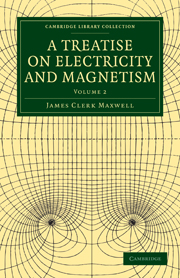Book contents
- Frontmatter
- Contents
- PART III MAGNETISM
- CHAPTER I ELEMENTARY THEORY OF MAGNETISM
- CHAPTER II MAGNETIC FORCE AND MAGNETIC INDUCTION
- CHAPTER III PARTICULAR FORMS OF MAGNETS
- CHAPTER IV INDUCED MAGNETIZATION
- CHAPTER V MAGNETIC PROBLEMS
- CHAPTER VI WEBER'S THEORY OF MAGNETIC INDUCTION
- CHAPTER VII MAGNETIC MEASUREMENTS
- CHAPTER VIII TERRESTRIAL MAGNETISM
- PART IV ELECTROMAGNETISM
- INDEX
- Plate section
CHAPTER I - ELEMENTARY THEORY OF MAGNETISM
Published online by Cambridge University Press: 05 July 2011
- Frontmatter
- Contents
- PART III MAGNETISM
- CHAPTER I ELEMENTARY THEORY OF MAGNETISM
- CHAPTER II MAGNETIC FORCE AND MAGNETIC INDUCTION
- CHAPTER III PARTICULAR FORMS OF MAGNETS
- CHAPTER IV INDUCED MAGNETIZATION
- CHAPTER V MAGNETIC PROBLEMS
- CHAPTER VI WEBER'S THEORY OF MAGNETIC INDUCTION
- CHAPTER VII MAGNETIC MEASUREMENTS
- CHAPTER VIII TERRESTRIAL MAGNETISM
- PART IV ELECTROMAGNETISM
- INDEX
- Plate section
Summary
371.] Certain bodies, as, for instance, the iron ore called loadstone, the earth itself, and pieces of steel which have been subjected to certain treatment, are found to possess the following properties, and are called Magnets.
If, near any part of the earth's surface except the Magnetic Poles, a magnet be suspended so as to turn freely about a vertical axis, it will in general tend to set itself in a certain azimuth, and if disturbed from this position it will oscillate about it. An unmagnetized body has no such tendency, but is in equilibrium in all azimuths alike.
372.] It is found that the force which acts on the body tends to cause a certain line in the body, called the Axis of the Magnet, to become parallel to a certain line in space, called the Direction of the Magnetic Force.
Let us suppose the magnet suspended so as to be free to turn in all directions about a fixed point. To eliminate the action of its weight we may suppose this point to be its centre of gravity. Let it come to a position of equilibrium. Mark two points on the magnet, and note their positions in space. Then let the magnet be placed in a new position of equilibrium, and note the positions in space of the two marked points on the magnet.
- Type
- Chapter
- Information
- A Treatise on Electricity and Magnetism , pp. 1 - 20Publisher: Cambridge University PressPrint publication year: 2010First published in: 1873

